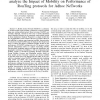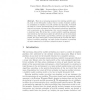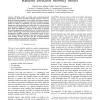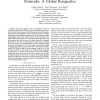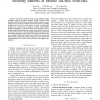106
Voted
AINTEC
2006
Springer
15 years 4 months ago
2006
Springer
Mobility models must scale accordingly to the application and reflect real scenarios in which wireless devices are deployed. Typical examples of scenarios requiring precise mobilit...
113
click to vote
INFOCOM
2003
IEEE
15 years 5 months ago
2003
IEEE
— A Mobile Ad hoc Network (MANET) is a collection of wireless mobile nodes forming a temporary network without using any existing infrastructure. Since not many MANETs are curren...
WAC
2005
Springer
15 years 6 months ago
2005
Springer
Abstract. There is an increasing consensus that existing mobility models, such as the well-known random walk or random waypoint models, are insufficient to represent real node mobi...
104
Voted
NETGAMES
2005
ACM
15 years 6 months ago
2005
ACM
In this position paper we propose an evaluation framework for networked mobile gaming, consisting of user, group, communication, and environment models. Each of these components a...
124
Voted
VALUETOOLS
2006
ACM
15 years 6 months ago
2006
ACM
— Considered is a mobile ad hoc network consisting of three types of nodes (source, destination and relay nodes) and using the two-hop relay routing protocol. Packets at relay no...
VTC
2006
IEEE
15 years 6 months ago
2006
IEEE
— Mobility models are widely used in simulation-based performance analyses of mobile networks. However, there is a trade-off between simplicity and realistic movement patterns. S...
120
Voted
LCN
2006
IEEE
15 years 6 months ago
2006
IEEE
— Recently, researchers have discovered that many of social, natural and biological networks are characterized by scale-free power-law connectivity distribution and a few densely...
94
Voted
INFOCOM
2006
IEEE
15 years 6 months ago
2006
IEEE
— Since the original work of Grossglauser and Tse, which showed that the mobility can increase the capacity of an ad hoc network, there has been a lot of interest in characterizi...
105
Voted
ICC
2008
IEEE
15 years 7 months ago
2008
IEEE
—The class of isotropic random walk mobility models, including Random Direction mobility model, Random Walk mobility model and Brownian motion mobility model, has been widely use...
100
Voted
GLOBECOM
2008
IEEE
15 years 7 months ago
2008
IEEE
Abstract—Simulation results of wireless networks heavily depend on the spatial distribution of its nodes. Even though the initial distribution may match the expectations of the r...

